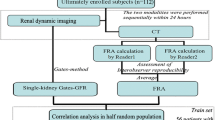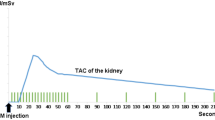Abstract
Purpose
To explore the feasibility of measuring glomerular filtration rate (GFR) using iodine maps in dual-energy spectral computed tomography urography (DEsCTU) and correlate them with the estimated GFR (eGFR) based on the equation of creatinine-cystatin C.
Materials and methods
One hundred and twenty-eight patients referred for DEsCTU were retrospectively enrolled. The DEsCTU protocol included non-contrast, nephrographic, and excretory phase imaging. The CT-derived GFR was calculated using the above 3-phase iodine maps (CT-GFRiodine) and 120 kVp-like images (CT-GFR120kvp) separately. CT-GFRiodine and CT-GFR120kvp were compared with eGFR using paired t-test, correlation analysis, and Bland–Altman plots. The receiver operating characteristic curves were used to test the renal function diagnostic performance with CT-GFR120kvp and CT-GFRiodine.
Results
The difference between eGFR (89.91 ± 18.45 ml·min−1·1.73 m−2) as reference standard and CT-GFRiodine (90.06 ± 20.89 ml·min−1·1.73 m−2) was not statistically significant, showing excellent correlation (r = 0.88, P < 0.001) and agreement (± 19.75 ml·min−1·1.73 m−2, P = 0.866). The correlation between eGFR and CT-GFR120kvp (66.13 ± 19.18 ml·min−1·1.73 m−2) was poor (r = 0.36, P < 0.001), and the agreement was poor (± 40.65 ml·min−1·1.73 m−2, P < 0.001). There were 62 patients with normal renal function and 66 patients with decreased renal function based on eGFR. The CT-GFRiodine had the largest area under the curve (AUC) for distinguishing between normal and decreased renal function (AUC = 0.951).
Conclusion
The GFR can be calculated accurately using iodine maps in DEsCTU. DEsCTU could be a non-invasive and reliable one-stop-shop imaging technique for evaluating both the urinary tract morphology and renal function.
Graphical abstract





Similar content being viewed by others
Abbreviations
- GFR:
-
Glomerular filtration rate
- eGFR:
-
Estimated glomerular filtration rate
- CTU:
-
Computed tomography urography
- CM:
-
Contrast material
- DECT:
-
Dual-energy computed tomography
- DEsCTU:
-
Dual-energy spectral computed tomography urography
- HU:
-
Hounsfield unit
- Scr:
-
Serum creatinine
- Cys C:
-
Cystatin C
- Hct:
-
Hematocrit
- VMI:
-
Virtual monochromatic images
- ASIR-V:
-
Adaptive statistical iterative reconstruction-V
- IC:
-
Iodine concentration
- CMF:
-
Contrast material filtration
- PC:
-
Plasma concentration
References
.Antonelli, A., et al., Elective partial nephrectomy is equivalent to radical nephrectomy in patients with clinical T1 renal cell carcinoma: results of a retrospective, comparative, multi-institutional study. BJU International, 2012. 109(7): p. 1013-1018. https://doi.org/https://doi.org/10.1111/j.1464-410X.2011.10431.x
.Campos, T.J.F.L., F.E. de V. Filho and M.F.H. Rocha, Assessment of the complexity of renal tumors by nephrometry (R.E.N.A.L. score) with CT and MRI images versus 3D reconstruction model images. International braz j urol, 2021. 47(4): p. 896-901. https://doi.org/https://doi.org/10.1590/S1677-5538.IBJU.2020.0930
.Jeong, S., et al., Estimation of renal function using kidney dynamic contrast material-enhanced CT perfusion: accuracy and feasibility. Abdominal Radiology, 2021. 46(5): p. 2045-2051. https://doi.org/https://doi.org/10.1007/s00261-020-02826-7
.Choi, J.D., et al., Renal Damage Caused by Warm Ischaemia During Laparoscopic and Robot-Assisted Partial Nephrectomy: An Assessment Using Tc 99m-DTPA Glomerular Filtration Rate. European Urology, 2010. 58(6): p. 900-905. https://doi.org/https://doi.org/10.1016/j.eururo.2010.08.044
.Wang, J., et al., The new Asian modified CKD-EPI equation leads to more accurate GFR estimation in Chinese patients with CKD. International urology and nephrology, 2016. 48(12): p. 2077-2081. https://doi.org/https://doi.org/10.1007/s11255-016-1386-9
.Noorbakhsh, A., et al., What a difference a delay makes! CT urogram: a pictorial essay. Abdominal Radiology, 2019. 44(12): p. 3919-3934. https://doi.org/https://doi.org/10.1007/s00261-019-02086-0
.You, S., et al., Determination of single-kidney glomerular filtration rate (GFR) with CT urography versus renal dynamic imaging Gates method. European Radiology, 2018. 28(3): p. 1077-1084. https://doi.org/https://doi.org/10.1007/s00330-017-5061-z
.Yuan, X., et al., Determination of Glomerular Filtration Rate with CT Measurement of Renal Clearance of Iodinated Contrast Material versus99m Tc-DTPA Dynamic Imaging “Gates” Method: A Validation Study in Asymmetrical Renal Disease. Radiology, 2017. 282(2): p. 552-560. https://doi.org/https://doi.org/10.1148/radiol.2016160425
.Becker, J., J. Babb and M. Serrano, Glomerular Filtration Rate in Evaluation of the Effect of Iodinated Contrast Media on Renal Function. American Journal of Roentgenology, 2013. 200(4): p. 822-826. https://doi.org/https://doi.org/10.2214/AJR.12.8871
.Hackstein, N., et al., Measuring Single-Kidney Glomerular Filtration Rate on Single-Detector Helical CT Using a Two-Point Patlak Plot Technique in Patients with Increased Interstitial Space. American Journal of Roentgenology, 2003. 181(1): p. 147-156. https://doi.org/https://doi.org/10.2214/ajr.181.1.1810147
.Zegadło, A., et al., Assessment of Solitary Pulmonary Nodules Based on Virtual Monochrome Images and Iodine-Dependent Images Using a Single-Source Dual-Energy CT with Fast kVp Switching. Journal of Clinical Medicine, 2020. 9(8): p. 2514. https://doi.org/https://doi.org/10.3390/jcm9082514
.Gutjahr, R., et al., Quantitative dual-energy CT material decomposition of holmium microspheres: local concentration determination evaluated in phantoms and a rabbit tumor model. European Radiology, 2021. 31(1): p. 139-148. https://doi.org/https://doi.org/10.1007/s00330-020-07092-1
.Mahmood, U., et al., Rapid switching kVp dual energy CT: Value of reconstructed dual energy CT images and organ dose assessment in multiphasic liver CT exams. European Journal of Radiology, 2018. 102: p. 102-108. https://doi.org/https://doi.org/10.1016/j.ejrad.2018.02.022
.Zhang, X., et al., Utilisation of virtual non-contrast images and virtual mono-energetic images acquired from dual-layer spectral CT for renal cell carcinoma: image quality and radiation dose. Insights into Imaging, 2022. 13(1). https://doi.org/https://doi.org/10.1186/s13244-021-01146-8
.Marcon, J., et al., Papillary vs clear cell renal cell carcinoma. Differentiation and grading by iodine concentration using DECT—correlation with microvascular density. European Radiology, 2020. 30(1): p. 1-10. https://doi.org/https://doi.org/10.1007/s00330-019-06298-2
.L’Hostis, F., et al., Detection and Characterization of Atypical Renal Cysts and Solid Renal Masses in Kidney Transplant Patients by Use of Dual-Energy CT Iodine Maps. American Journal of Roentgenology, 2019. 213(1): p. 115-122. https://doi.org/https://doi.org/10.2214/AJR.18.20574
.Achille, M., et al., Accuracy of contrast-enhanced dual-energy MDCT for the assessment of iodine uptake in renal lesions. AJR. American journal of roentgenology, 2014. 202(5). https://doi.org/https://doi.org/10.2214/AJR.13.11450
.Inker, L.A., et al., Estimating Glomerular Filtration Rate from Serum Creatinine and Cystatin C. New England Journal of Medicine, 2012. 367(1): p. 20-29. https://doi.org/https://doi.org/10.1056/NEJMoa1114248
.Levey, A.S., et al., The definition, classification, and prognosis of chronic kidney disease: a KDIGO Controversies Conference report. Kidney International, 2011. 80(1): p. 17-28. https://doi.org/https://doi.org/10.1038/ki.2010.483
.Cheng, K., et al., CT urography: how to optimize the technique. Abdominal Radiology, 2019. 44(12): p. 3786-3799. https://doi.org/https://doi.org/10.1007/s00261-019-02111-2
.Park, J.J., B.K. Park and C.K. Kim, Single-phase DECT with VNCT compared with three-phase CTU in patients with haematuria. European Radiology, 2016. 26(10): p. 3550-3557. https://doi.org/https://doi.org/10.1007/s00330-016-4206-9
.Meeusen, J.W., et al., Performance of Cystatin C– and Creatinine-Based Estimated Glomerular Filtration Rate Equations Depends on Patient Characteristics. Clinical Chemistry, 2015. 61(10): p. 1265-1272. https://doi.org/https://doi.org/10.1373/clinchem.2015.243030
.Stevens, P.E., Evaluation and Management of Chronic Kidney Disease: Synopsis of the Kidney Disease: Improving Global Outcomes 2012 Clinical Practice Guideline. Annals of Internal Medicine, 2013. 158(11): p. 825. https://doi.org/https://doi.org/10.7326/0003-4819-158-11-201306040-00007
.Lin, Z., et al., Automated segmentation of kidney and renal mass and automated detection of renal mass in CT urography using 3D U-Net-based deep convolutional neural network. European Radiology, 2021. 31(7): p. 5021-5031. https://doi.org/https://doi.org/10.1007/s00330-020-07608-9
.Kwon, S.H., et al., Determination of Single-Kidney Glomerular Filtration Rate in Human Subjects by Using CT. Radiology, 2015. 276(2): p. 490-498. https://doi.org/https://doi.org/10.1148/radiol.2015141892
.Jiang, K., et al., A modified two-compartment model for measurement of renal function using dynamic contrast-enhanced computed tomography. PLoS One, 2019. 14(7): p. e0219605. https://doi.org/https://doi.org/10.1371/journal.pone.0219605
.Wang, T., et al., Measurement of Glomerular Filtration Rate Using Multiphasic Computed Tomography in Patients With Unilateral Renal Tumors: A Feasibility Study. Frontiers in Physiology, 2019. 10. https://doi.org/https://doi.org/10.3389/fphys.2019.01209
.Ferguson, C.M., et al., Renal Adiposity Does not Preclude Quantitative Assessment of Renal Function Using Dual-Energy Multidetector CT in Mildly Obese Human Subjects. Academic Radiology, 2019. 26(11): p. 1488-1494. https://doi.org/https://doi.org/10.1016/j.acra.2018.12.008
.Harsaker, V., et al., Quantitative benchmarking of iodine imaging for two CT spectral imaging technologies: a phantom study. European Radiology Experimental, 2021. 5(1). https://doi.org/https://doi.org/10.1186/s41747-021-00224-2
.Sofue, K., et al., Dual-energy computed tomography for non-invasive staging of liver fibrosis: Accuracy of iodine density measurements from contrast-enhanced data. Hepatol Res, 2018. 48(12): p. 1008-1019. https://doi.org/https://doi.org/10.1111/hepr.13205
Author information
Authors and Affiliations
Corresponding author
Ethics declarations
Conflict of interest
The author(s) declared no potential conflicts of interest with respect to the research, authorship, and/or publication of this article.
Ethical approval
This retrospective study was approved by the medical ethics committee of the First Affiliated Hospital of Dalian Medical University [Ethics References No: PJ-KS-KY-2019-110]. Written informed consent from subjects was waived by the ethics committee.
Additional information
Publisher's Note
Springer Nature remains neutral with regard to jurisdictional claims in published maps and institutional affiliations.
Supplementary Information
Below is the link to the electronic supplementary material.
Rights and permissions
Springer Nature or its licensor (e.g. a society or other partner) holds exclusive rights to this article under a publishing agreement with the author(s) or other rightsholder(s); author self-archiving of the accepted manuscript version of this article is solely governed by the terms of such publishing agreement and applicable law.
About this article
Cite this article
Wang, S., Tong, X., Zhang, J. et al. Estimation of renal function using iodine maps in dual-energy spectral computed tomography urography: a feasibility and accuracy study. Abdom Radiol 49, 997–1005 (2024). https://doi.org/10.1007/s00261-023-04146-y
Received:
Revised:
Accepted:
Published:
Issue Date:
DOI: https://doi.org/10.1007/s00261-023-04146-y




